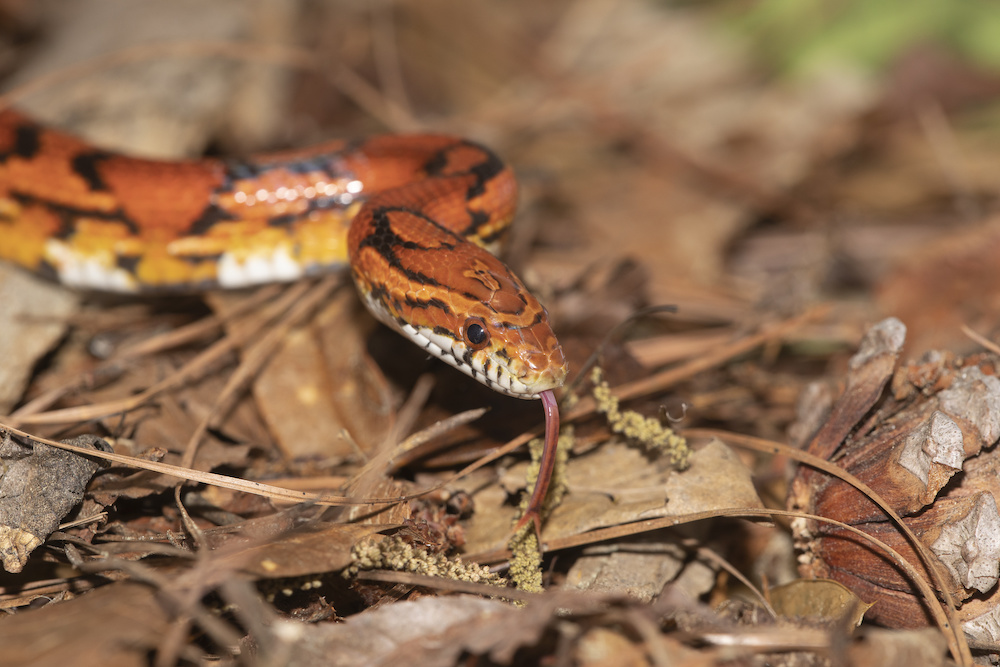North Carolina Snakes: Everything You Need To Know

Greg Lewbart has always been a snake guy.
As a kid, he’d collect snakes as pets on and off. In graduate school, his snake menagerie topped out at 14, all non-venomous. He eventually ended up holding on to just one, a python named Roscoe, for 35 years. He doesn’t own a snake now, but treats and cares for them on a regular basis as part of his job at the NC State College of Veterinary Medicine.
“There was always just this innate fascination I had with them. I’ve never, ever felt scared of them,” says Lewbart, professor of aquatic animal medicine. “My main thing is to spread the word that snakes are OK. That yes, some are dangerous, but if you respect them and pretty much leave them alone, we can coexist.”
In that spirit, we asked Lewbart to shed (sorry) some light on the snakes of North Carolina, how much of a threat they are to humans and pets and more.

What is it like in North Carolina with snakes heading into the summer?
They’re really active right now. Their big time is probably between May and September. The summer is their time to feed and breed.
Their activity is dictated by the temperature to a degree. But in the heat of the day, like the days we’re having now, they’re not going to be out as much. They’re going to be seeking shelter from the direct sun.
You can maybe see them out and about in the mornings and the evenings, like dawn and dusk. Unless they’re hunting or looking for a mate, they’re pretty cryptic. You typically have to make a real effort to find them.
So even if someone’s working in their backyard that doesn’t make them more active?
Right, unless they feel threatened. Let’s say someone’s working in their backyard by a woodpile or a bunch of mulch, and they have a shovel or a rake or a saw and they disturb the snake. The snake’s probably going to react and usually that reaction is going to be to crawl away, but they will also defend themselves if they need to.
If they feel like they can’t get away and their better option is to stay and hold their ground, most any snake will do that. If they’re going away from you, then everybody wins. If they’re holding their ground, then the best thing is just to move away.
Talk to me a little bit about the different species that are in the state. How many of those are considered venomous?
There are 37 species of snakes in North Carolina and seven are venomous. There are basically three families of snakes in North Carolina. The first to consider is the non-venomous Colubridae, which includes the garter snakes, king snakes and rat snakes.
There’s quite a variety of sizes in this group, from an adult that is maybe 12 inches long, such as a little brown snake, to 6 or 7 feet for some of the big rat snakes. These snakes are technically harmless. They don’t have a potent venom that could hurt a person or pet.
The Elapidae is the fixed, front fang venomous snake family. Cobras are in this family, but we don’t have cobras in North Carolina. We do have the coral snake, but only in the most southeastern part of the state. They’re small and generally not very aggressive, but they’re pretty toxic.
Then we have the Viperidae. These would be the cottonmouths, copperheads and rattlesnakes. The big problem snake for most people in this state is the copperhead. They are venomous. They can be aggressive to dogs, cats and people if you get in their way. And they blend in well. If you step on one, it’s probably going to try and bite you. It’s common, but the good news is it’s rarely fatal to people and pets.
What is the bite like?
It’s going to be painful. You’re going to have a lot of swelling, but you probably won’t need antivenom (aka: antivenin). Any person and any pet bitten by a venomous snake should seek professional medical attention.
And then there’s the water moccasin or the cottonmouth. This is the snake issue that bugs me the most because people see a snake in the water and they want to say it’s a water moccasin or a cottonmouth, which are two names for the same species. We don’t even have them in Wake County. So if you’re at Jordan Lake or Lake Johnson or Lake Wheeler, and you see a snake in the water it’s not a cottonmouth. It’s a harmless water snake.
What about rattlesnakes?
We have a few species of rattlesnakes in the state, but no rattlesnakes live in Wake County. If you go east, there are pygmy rattlesnakes and the canebrake rattlesnake, which is a variant of the timber rattler. If you go west, we have the timber rattler in the mountains. The diamondback rattler can be found in the southeast, but are rarely seen.
Are there different types of environments in North Carolina where you’re more likely to encounter snakes?
Probably in areas that are less developed, but it does seem like urbanization attracts some kinds of snakes. With people and food and pets come rats and mice; we’re increasing the prey base. We see tons of deer and Canada geese in almost unnatural numbers, and that’s because we’ve made habitats they like.
That said, if you want to live somewhere in this state, the central region of North Carolina is about as good as you’re going to get when it comes to snake safety.
Say you’re working in your yard, you’ve seen snakes before there and you’re concerned about it. What can you do to protect yourself?
One would be wearing really good boots if you’re going to be working where there are copperheads. Another approach is getting rid of snake-harboring habitats such as woodpiles, tarps, or upside-down plastic swimming pools. You’ll find snakes in all of these places.
What should you do and not do if you encounter a snake and you don’t know what kind it is?
Twenty-five years ago, someone would tell me that they saw a snake in their yard or playground. And I’d ask, “What does it look like?” And they’d say, “Well, it was brown and white. I think.”
Now you can take a picture with your cellphone and identify it pretty easily online yourself. But I wouldn’t expect someone to know how to handle a venomous snake in order to safely relocate it, and I would not recommend that. The best thing if you want peace of mind is to get a picture of it without getting too close to see what field marks you can use to identify it. Otherwise, I would walk the other way.
What kind of threat do snakes pose to dogs and cats?
If a dog or cat has been bitten by a venomous snake, you’ll know it. They will scream, it will be painful and it will swell quickly. For dogs, it will likely be on the face. Dogs kind of snoop around and explore with their face. Cats are more wary, approach things slowly and use their paws to investigate. For any bite to a pet I would seek veterinary care.
Do snakes stay away from pets the same way they stay away from people?
Yes, but it’s still good to be cautious, especially if you’re doing activities such as hiking in the woods or walking your dog on a trail or in a park. It’s not great to let dogs wander into the brush. Last year, I was running with my dog and we ran right over a copperhead. I saw it, the dog didn’t and at the last second I pulled on his leash to go around the copperhead.

What are some of the most common misconceptions people have about snakes?
One pet peeve of mine is people assuming a snake is venomous without trying to identify it. When you move somewhere, it’s a good idea to learn what snakes live in your neighborhood or immediate area. You don’t have to know all 37 species, but maybe you should know half a dozen that you might encounter.
What I’m not OK with is people killing a snake just because it’s a snake and that they react sort of viscerally with a shovel or hoe. People should just think about them as just another wild animal and respect them for that.
What is their most important role in the ecosystem?
Their role is generally helpful. They control rodents. There are part of the checks and balances system so that we don’t have too many frogs or we don’t get too many fish or we don’t get too many rodents. Snakes are similar to sharks. A lot of people don’t like sharks but most people are fascinated by sharks. I think snakes are a little bit like that. But if you don’t have a top-level predator like a shark or a snake then you end up with a prey species imbalance, and you can end up with lots of different problems like poor water quality and unchecked disease. Snakes benefit us in the way that they benefit the ecosystem as a whole.
~Jordan Bartel/NC State Veterinary Medicine
• This story has been corrected to accurately describe the fangs of the Elapidae family.


